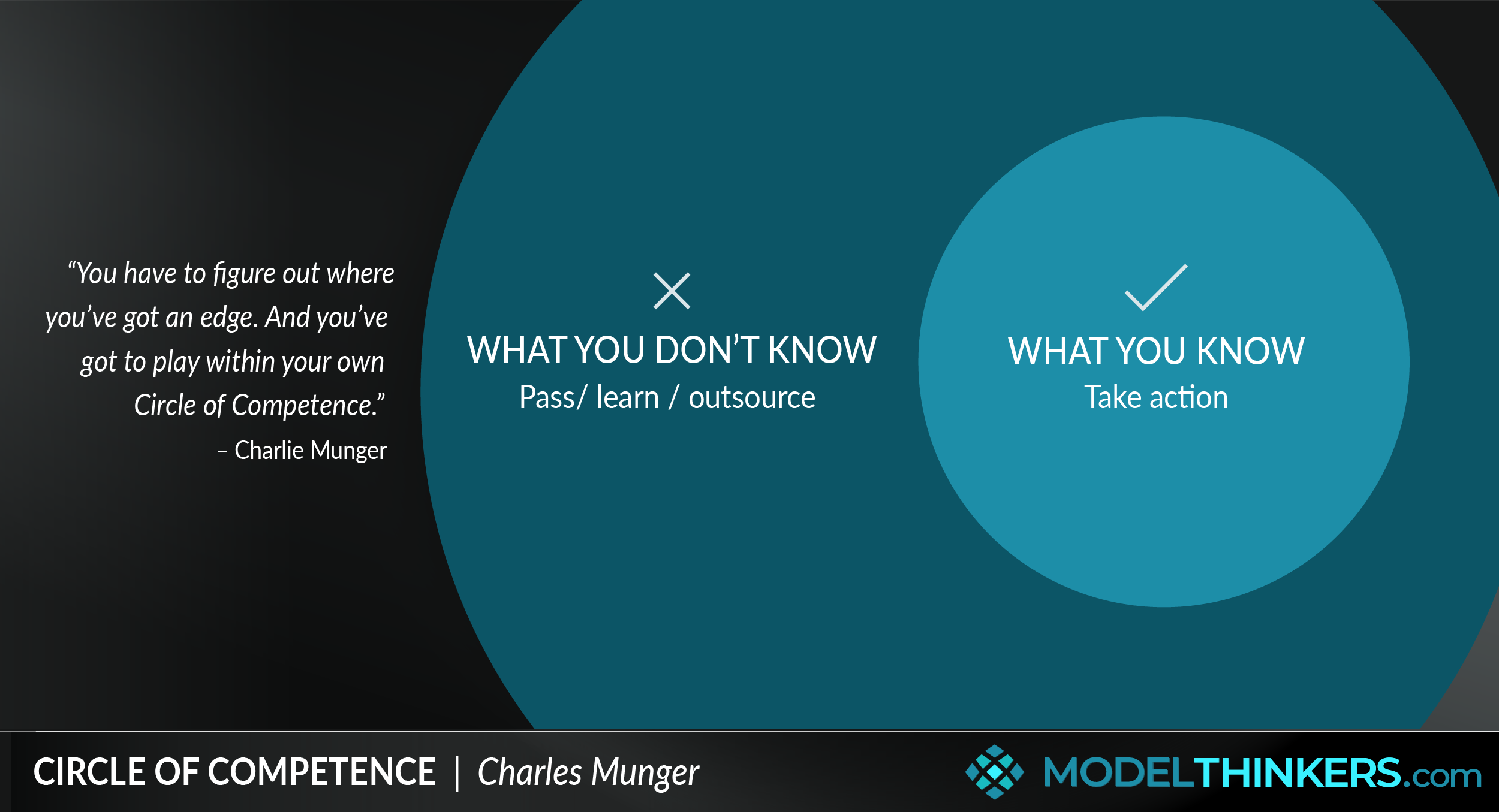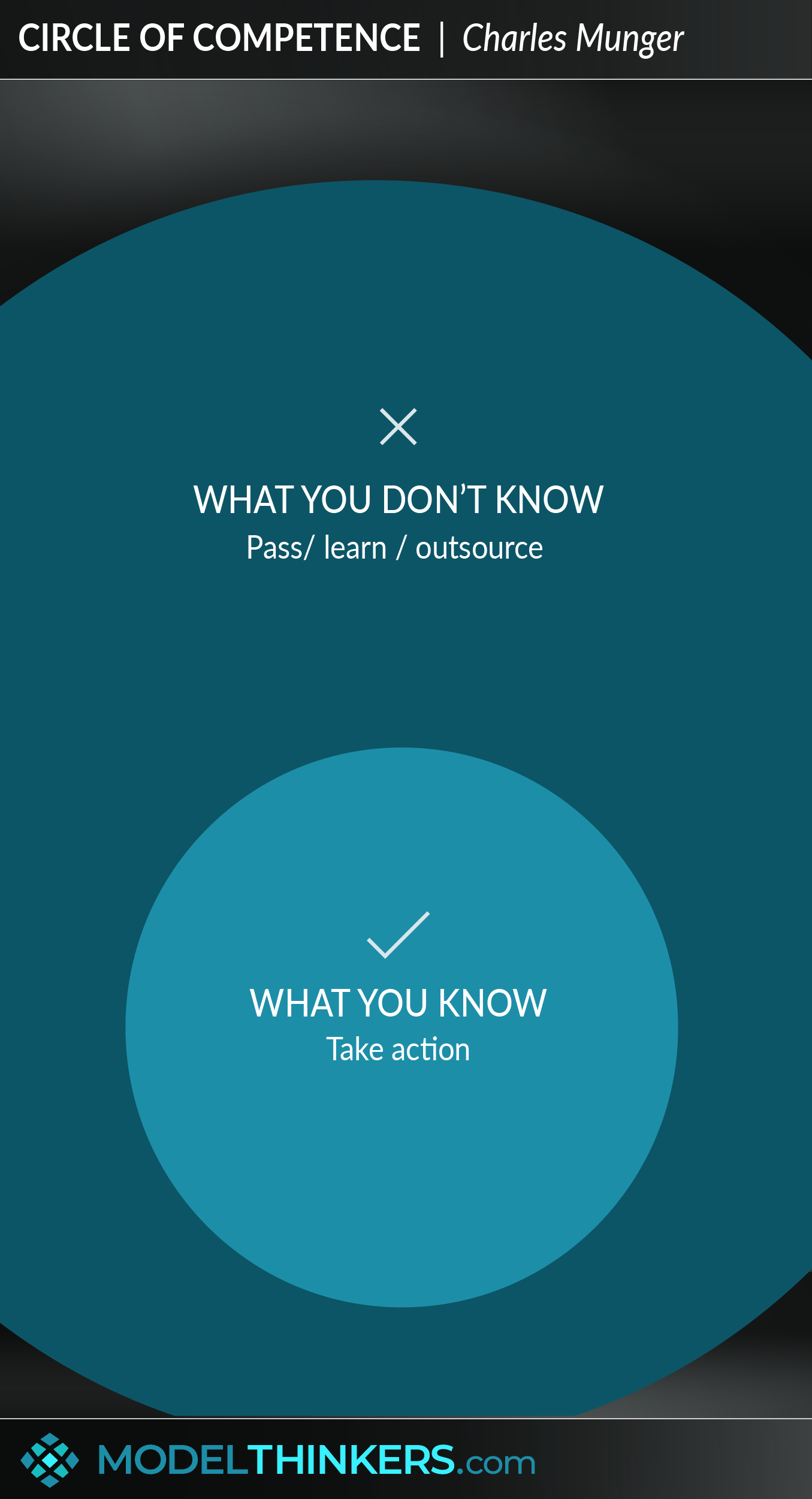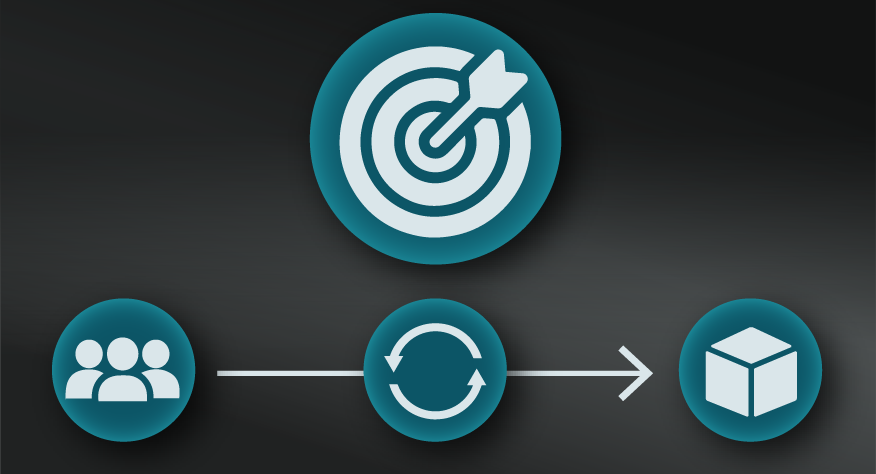

 0 saved
0 saved
 33.9K views
33.9K views








“I don’t play in a game where the other people are wise and I’m stupid. I look for a place where I’m wise and they’re stupid. You have to know the edge of your own competency. I’m very good at knowing when I can’t handle something.” — Charlie Munger
Your Circle of Competence identifies your current area of knowledge and expertise as a guide for effective action.
BUFFET ON THE CIRCLE AND BASEBALL.
When talking about the Circle of Competence, Warren Buffett often discussed baseball. He referenced a lesson from a book entitled ‘The Science of Hitting’, which discussed batter Ted Williams, and his approach to breaking down his batting zone into 77 imaginary segments. Williams had analysed his chance of hitting a pitch in each segment, clearly identifying his hit zone or Circle of Competence as a result, and therefore knowing when he should swing and when he should let a pitch sail past.
Buffett explained: “I can look at a thousand different companies, I don't have to be right on every one of them, or even fifty of them. I can pick the ball I want to hit. The trick to investing is to just sit there and watch pitch after pitch go by and if people are yelling ‘swing you bum’. Ignore them.”
APPLICATION.
Applying the model involves identifying what lies within your Circle of Competence and then making decisions and taking action from within that circle only. Once you assess a challenge in terms of your Circle of Competence, it provides a guide as to the sort of action you should prioritise and invest in. When faced with a necessary decision point outside of your Circle of Competence, you have several choices that include:
-
Pass on it by letting it go by and not engaging with it;
-
Learn about it by developing expertise and growing your Circle of Competency as a result; or
-
Outsource by consulting, engaging, or partnering with someone else who has the issue within their Circle of Competence.
In deciding which of the above options to explore, ask how much you really want to invest into areas outside your Circle of Competence and whether you would be better finding alternative opportunities that play to your existing strengths. Identifying other people’s Circle of Competency also helps you to develop more meaningful partnerships and collaborations.
SELF AWARENESS.
When trying to understand this concept, it is crucial to distinguish between what we think we know and what we really know. It takes a high degree of self-awareness, courage and humility, as well as being open to evidence, to clearly identify and state those boundaries. Ideally, when you assess your Circle of Competence in relation to a challenge, you would consider actual data and your history in the relevant area rather than simply your impression of what you are capable of.
Communicating your Circle of Competence is also a way of building trust. Rather than bluffing about something, this involves having the confidence, transparency, and humility to say something like, “I don’t know, but I can find out.”
TRUSTING YOUR GUT.
You can also use this model to help inform when you trust your gut and when you should take a more sceptical approach. Trusting your gut is essentially about falling back on your Fast Thinking, or tacit pattern recognition built up through experience and assumptions. It works when you have deep expertise in an area and the new situation is consistent with past experiences. In other words, when it's in your Circle of Competence, you can likely act fast by trusting your gut.
IN YOUR LATTICEWORK.
A true assessment of your Circle of Competence will be impacted by a number of heuristics including the Confirmation Heuristic. Most people applying the Circle of Competence use it to focus on strengths, a counter view to this is one that prioritises Diversification. When you do apply this approach in a team context you might want to consider developing T-Shaped people and teams, as well as applying Apple’s Directly Responsible Individual approach to reflect competency.
Other challenges or more creative approaches to this model might include applying Idea Sex to build competency in unique or niche areas, and applying Deliberate Practice when you decide to extend your Circle of Competence into a new area.




- Play to your strengths
Identifying and acting from your circle of competence involves acting from a place of strength and relative certainty. It reduces risk and is more likely to achieve desired results.
- Use passions and interests to help identify your circle of competence.
Passions and interests are an indicator of your likely Circle of Competence, though they are not always the defining factor.
- Engage with people from their Circle of Competence.
Identify other people’s circle of competence, especially key collaborators, and engage with them from that standpoint — extracting expertise from their places of strength.
- Grow and learn.
Your Circle of Competence is not static, use it to identify the boundaries of your expertise so you can continually challenge yourself and grow.
- Supplement yourself with diversity.
Work with people who have complementary circles of competence to round out and achieve effective decisions.
- Say ‘I don’t know, but I’ll find out.’
Be courageous in identifying and stating the boundaries of your Circle of Competence while still being prepared to discover more.
Identifying the limits of your Circle of Competence is likely to be unreliable in the context of unconscious bias, particularly the illusion of competence.
This mental model might be interpreted as an argument to focus on specialising deeply at the expense of extraneous knowledge domains. However, it might be argued that broadening your understanding of a range of fields will add to your existing specialist knowledge
Finally, given that learning generally requires moving into areas of uncertainty and discomfort, it could be argued that focusing on your circle of competence prevents opportunities to learn.
Andrew Carnegie and investing.
Andrew Carnegie, a well-known industrialist of the 19th century, is considered as the possible originator of this mental model, arguing that people should concentrate their time, money and investments solely within their circle of competence. He practised this approach by focusing on the steel industry.
Buffett's baseball analogy
We referenced Buffett's baseball analogy in the main overview. Those comments were made in the documentary Becoming Warren Buffet, where he discussed a baseball comparison when considering the Circle of Competence. He referenced a lesson from a book entitled ‘The Science of Hitting’, see the video below for more.
The circle of competence requires a level of self-awareness. While used by Buffet in an investment context, it can be applied quite broadly.
Use the following examples of connected and complementary models to weave the circle of competence into your broader latticework of mental models. Alternatively, discover your own connections by exploring the category list above.
Connected models:
- Circle of concern and influence: to understand what you can impact on.
Complementary models:
- Illusions of competence: to identify areas that you believe you are competent in but aren’t.
- Feedback loops: to provide a reality check about real areas of competence.
- Growth mindset: to consider areas of competence you might develop.
- Deliberate practice: conscious skills development.
- T-shaped capabilities: for combining broad and deep competence
Circle of Competence was loosely outlined by Warren buffet for the first time in his 1996 shareholder letter although Charlie Munger has helped to popularise the mental model. A similar approach can be traced all the way back to Andrew Carnegie.
 My Notes
My Notes
Oops, That’s Members’ Only!
Fortunately, it only costs US$5/month to Join ModelThinkers and access everything so that you can rapidly discover, learn, and apply the world’s most powerful ideas.
ModelThinkers membership at a glance:






“Yeah, we hate pop ups too. But we wanted to let you know that, with ModelThinkers, we’re making it easier for you to adapt, innovate and create value. We hope you’ll join us and the growing community of ModelThinkers today.”








































































































































